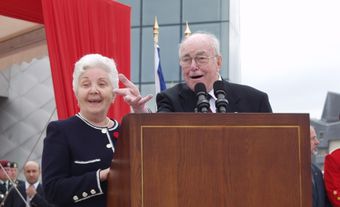
Background
Isaac Brock was killed on 13 October 1812 in the Battle of Queenston Heights. He was leading a charge to retake a gun emplacement on Queenston Heights’ northern slope that had been captured by the invading American forces when he was shot in the wrist and chest. Before the battle at Queenston Heights, Brock had, with the help of Indigenous warriors, captured Fort Michilimackinac in July 1812 as well as Detroit that August.
The War of 1812 dragged on for more than two years after Brock’s death at Queenston Heights, but for many Upper Canadians he became the conflict’s central symbol. He was held up as a hero and a unifying figure for the people of the province, many of whom wanted to honour him with a fitting monument.
Description

The monument, which still stands on Queenston Heights, is made of Queenston limestone and stands 57 m high. At the time it was completed, it was the second highest monument in the world, surpassed only by Christopher Wren’s monument commemorating the Great Fire of London. The monument’s base features sculpted lions and depictions of Brock’s achievements. The monument also has a fluted column that contains 235 steps leading to an enclosed observation deck. An impressive 4.8-m stone-carved statue of Sir Isaac Brock in a heroic pose stands atop the monument.
Access to the small platform at the top of the column, where one can view the heights and the Niagara River through portholes, was closed for several years and reopened in 2010 after a $1-million refurbishing. The monument is owned by Parks Canada.
The First Monument to Sir Isaac Brock
On 14 March 1814, the Parliament of Upper Canada passed an Act to erect a monument to commemorate Sir Isaac Brock on Queenston Heights. The Legislature approved the sum of £500 for the monument. The following March, the provincial parliament granted a further £500 to the project, and selected a steering committee for it.
The committee wrote to Brock’s brother William to ask for the family’s views on what kind of memorial to erect. The family responded two years later that they had asked sculptor Richard Westmacott, who had designed a monument to Brock housed in London’s Saint Paul’s Cathedral, to design the Queenston Heights monument. Perhaps due to its high price tag, the committee rejected Westmacott’s design and instead selected a design by an engineer named Francis Hall. His design was for a Tuscan column.
Work began on the monument in the spring of 1824, and on the battle’s anniversary that fall the remains of Brock and his aide-de-camp, John Macdonell, were removed from Fort George and reinterred under the new monument. The ceremony was attended by over 8,000 people. The first monument honouring Brock was largely completed in 1827, though some elements of the original design were never carried out. It stood just over 41 m high, and had an interior staircase that led to an observation deck at its apex. The monument stood at the edge of the escarpment until 17 April 1840, when it was badly damaged by an explosion. The charge was supposedly set by Benjamin Lett, an Irish Canadian who had allegedly been involved in the 1837 rebellion. Following the explosion, the monument was cracked on one side and shattered above the gallery.
The Second Monument to Sir Isaac Brock
On 30 July 1840, some 8,000 people gathered on Queenston Heights to determine what should be done about the monument’s destruction. The speakers at the gathering argued that a new memorial should be built to honour the hero as soon as possible, and it was resolved to create a new monument committee. After the rubble of the damaged monument was removed, the bodies of Brock and Macdonell were disinterred and reburied in the Hamilton family cemetery in Queenston.
In 1842, the commissioners held a contest to select the new monument’s design and chose an Egyptian-style obelisk designed by Toronto’s Thomas Young. However, the committee ran into funding problems as, unlike the previous monument, the provincial government did not allocate any funds to the second memorial. The project lost momentum until 1852, when the committee’s funds reached £5,794. They then decided to hold another design contest, which resulted in the selection of a design by architect William Thomas, who had gained acclaim for the design of several churches, notably Saint Michael’s Cathedral in Toronto. The cornerstone of the new monument on Queenston Heights was laid on the anniversary of Brock’s death, 13 October, in 1853. The remains of Brock and Macdonell were reinterred in new caskets at its base. Between 12,000 and 15,000 people gathered on Queenston Heights for the ceremony.
Construction work continued after the gathering, and the new monument was inaugurated on 13 October 1859. Thousands of people from around the province gathered on the heights to commemorate Brock and celebrate his new monument.

 Share on Facebook
Share on Facebook Share on X
Share on X Share by Email
Share by Email Share on Google Classroom
Share on Google Classroom


